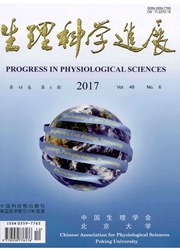

 中文摘要:
中文摘要:
缝隙连接(gap junctions,GJ)是细胞间直接通讯的管道,广泛存在于中枢神经系统中,传递不同神经元细胞间的化学信息和电信息,除了已知的代谢调控、离子缓冲、能量转移等功能外,也涉及"钙波"、ATP受体信号等,在调节神经发育和维持神经系统特有的功能方面发挥着重要的作用.同时,缝隙连接通过开放调节,参与病理生理过程,调节局部代谢物浓度,维持代谢稳态;其中钙信号作为主要通讯方式作用尤为突出,但其作用尚存争议.中枢神经系统内缝隙连接作用是否存在细胞选择性,是否依赖特定信号通路或其它物理过程仍有待于进一步的研究.
 英文摘要:
英文摘要:
Gap junction is a direct communication between the cells as the channel, which exists widely in the central nervous system involving in transporting the electronic and chemical messages between neu- rons and glias. It plays roles in regulation of metabolism, ion buffer, "calcium wave" as well ATP recep- tor signal. Gap junction also has been complicated in the nerve growth and development. Switching the gap junction participates in pathological process and maintainning the local metabolites concentration. Calcium wave is the prominently regulated by gap junction. In the central nervous system, it is remain to be elucidated whether the gap junction play roles in embryonic development and pathophysiological processes.
 同期刊论文项目
同期刊论文项目
 同项目期刊论文
同项目期刊论文
 期刊信息
期刊信息
